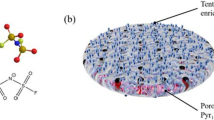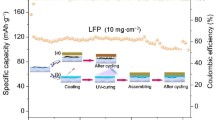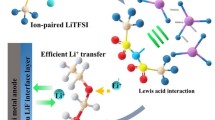Abstract
Lithium (Li) metal has been considered as a potential substitute for the graphite anode in Li-ion batteries to further boost their energy density. Polymer electrolytes (PEs) are expected to be applied in Li metal batteries (LMB) to replace liquid electrolytes due to safety concerns. Among others, poly(vinylidene fluoride-co-hexafluoropropylene) (PVDF-HFP)-based electrolytes offer clear advantages such as improved processability and chemical/electrochemical stability. However, Li dendrite growth in LMBs and the low Li-ion conductivity of solid polymer electrolytes (SPEs) still hinder their practical applications. To address this issue, it has been proposed that solvent-enhanced PVDF-HFP-based polymer electrolytes (SPPEs) with a tuned amount of residual N-methyl-2-pyrrolidone (NMP) could provide improved ionic conductivity and outstanding chemical/electrochemical stability. We report herein the effects of different salts, polymer, and additives on the electrochemical performance and interface stability of SPPEs. We demonstrate that lithium salts and blended polymers play a pivotal role in the electrochemical performance of SPPEs. In addition, additives exert a remarkable effect on the stripping/plating behaviors of metallic lithium anode in SPPEs. SPPEs with adequate LiNO3 are found to be stable with lower overpotentials at 0.5 mA cm−2 on cycling of symmetrical Li cells. These results highlight novel SPPE strategies for optimizing the ionic conductivity and stabilizing the lithium metal anodes.





Similar content being viewed by others
References
Z. Li, J. Huang, B.Y. Liaw, V. Metzler, and J.B. Zhang, J. Power Sources 254, 168 (2014).
D. Aurbach, E. Zinigrad, Y. Cohen, and H. Teller, Solid State Ionics 148, 405 (2002).
Q. Zhao, X.T. Liu, S. Stalin, K. Khan, and L.A. Archer, Nat. Energy 4, 365 (2019).
Y.J. Shen, M.J. Reddy, and P.P. Chu, Solid State Ionics 175, 747 (2004).
J.Q. Zhang, B. Sun, X.D. Huang, S.Q. Chen, G.X. Wang. Sci Rep-Uk 4, (2014).
W.H. Pu, X.M. He, L. Wang, C.Y. Jiang, and C.R. Wan, J. Membrane Sci. 272, 11 (2006).
X. Zhang, S. Wang, C.J. Xue, C.Z. Xin, Y.H. Lin, Y. Shen, L.L. Li, C.W. Nan, Adv. Mater. 32, (2020).
X. Zhang, S. Wang, C.J. Xue, C.Z. Xin, Y.H. Lin, Y. Shen, L.L. Li, C.W. Nan, Adv. Mater. 31, (2019).
P.C. Yao, B. Zhu, H.W. Zhai, X.B. Liao, Y.X. Zhu, W.H. Xu, Q. Cheng, C. Jayyosi, Z. Li, J. Zhu, K.M. Myers, X. Chen, and Y. Yang, Nano Lett. 18, 6113 (2018).
C.V. Amanchukwu, Z. Yu, X. Kong, J. Qin, Y. Cui, and Z.N. Bao, J. Am. Chem. Soc. 142, 7393 (2020).
P. Barai, K. Higa, and V. Srinivasan, Phys. Chem. Chem. Phys. 19, 20493 (2017).
X.R. Chen, Y.X. Yao, C. Yan, R. Zhang, X.B. Cheng, and Q. Zhang, Angew. Chem. Int. Ed. 59, 7743 (2020).
S. Bag, C. Zhou, P.J. Kim, V.G. Pol, and V. Thangadurai, Energy Storage Mater. 24, 198 (2020).
J. Deng, T.Y. Xiong, H.Y. Wang, A.M. Zheng, and Y. Wang, ACS Sustain. Chem. Eng. 4, 3750 (2016).
Peter, V., Wright, Br. Polym. J. (1975).
S.K. Chaurasia, and A. Chandra, Solid State Ionics 307, 35 (2017).
M.M.E. Jacob, S.R.S. Prabaharan, and S. Radhakrishna, Solid State Ionics 104, 267 (1997).
G. Bieker, M. Winter, and P. Bieker, Phys. Chem. Chem. Phys. 17, 8670 (2015).
Q.C. Liu, J.J. Xu, S. Yuan, Z.W. Chang, D. Xu, Y.B. Yin, L. Li, H.X. Zhong, Y.S. Jiang, J.M. Yan, and X.B. Zhang, Adv. Mater. 27, 5241 (2015).
J. Pan, Y.T. Cheng and Y. Qi, Phys. Rev. B 91, 134116 (2015).
Y.Y. Lu, Z.Y. Tu, and L.A. Archer, Nat. Mater. 13, 961 (2014).
C. Yan, X.B. Cheng, Y. Tian, X. Chen, X.Q. Zhang, W.J. Li, J.Q. Huang, and Q. Zhang, Adv. Mater. 30, 1707629 (2018).
X.Q. Zhang, X.B. Cheng, X. Chen, C. Yan, and Q. Zhang, Adv. Funct. Mater. 27, 1605989 (2017).
R. Elazari, G. Salitra, G. Gershinsky, A. Garsuch, A. Panchenko, and D. Aurbach, Electrochem. Commun. 14, 21 (2012).
T. Lapp, S. Skaarup, and A. Hooper, Solid State Ionics 11, 97 (1983).
S.F. Liu, X. Ji, N. Piao, J. Chen, N. Eidson, J.J. Xu, P.F. Wang, L. Chen, J.X. Zhang, T. Deng, S. Hou, T. Jin, H.L. Wan, J.R. Li, J.P. Tu, and C.S. Wang, Angew. Chem. Int. Ed. 60, 3661 (2021).
C.M. Burke, V. Pande, A. Khetan, V. Viswanathan, and B.D. McCloskey, Proc. Natl. Acad. Sci. USA 112, 9293 (2015).
X.F. Yang, M. Jiang, X.J. Gao, D. Bao, Q. Sun, N. Holmes, H. Duan, S. Mukherjee, K. Adair, C.T. Zhao, J.W. Liang, W.H. Li, J.J. Li, Y. Liu, H. Huang, L. Zhang, S.G. Lu, Q.W. Lu, R.Y. Li, C.V. Singh, and X.L. Sun, Energ. Environ Sci. 13, 1318 (2020).
E. Markevich, G. Salitra, F. Chesneau, M. Schmidt, and D. Aurbach, ACS Energy Lett. 2, 1321 (2017).
B.D. Adams, J.M. Zheng, X.D. Ren, W. Xu, and J.G. Zhang, Adv. Energy Mater. 8, 1702097 (2018).
K. Park and J.B. Goodenough, Adv. Energy Mater. 7, 1700732 (2017).
Acknowledgments
This work is supported by ZJNSF (No. LR20E010001), National Key Research and Development Program of China (No. SQ2018YFE011526), Zhejiang Provincial Key Research and Development Program (2021C01004 and 2019C01121), Chao Kuang Piu High Tech Development Fund (2020ZL012), and Aeronautical Science Foundation (2019ZF076002).
Author information
Authors and Affiliations
Corresponding author
Ethics declarations
Conflict of Interest
The authors declare that they have no conflicts of interest.
Additional information
Publisher’s Note
Springer Nature remains neutral with regard to jurisdictional claims in published maps and institutional affiliations.
Rights and permissions
About this article
Cite this article
Wang, Y., Qin, F. Effects of Components in Solvent-Enhanced PVDF-HFP-Based Polymer Electrolyte on Its Electrochemical Performance. J. Electron. Mater. 50, 5049–5056 (2021). https://doi.org/10.1007/s11664-021-08971-z
Received:
Accepted:
Published:
Issue Date:
DOI: https://doi.org/10.1007/s11664-021-08971-z




